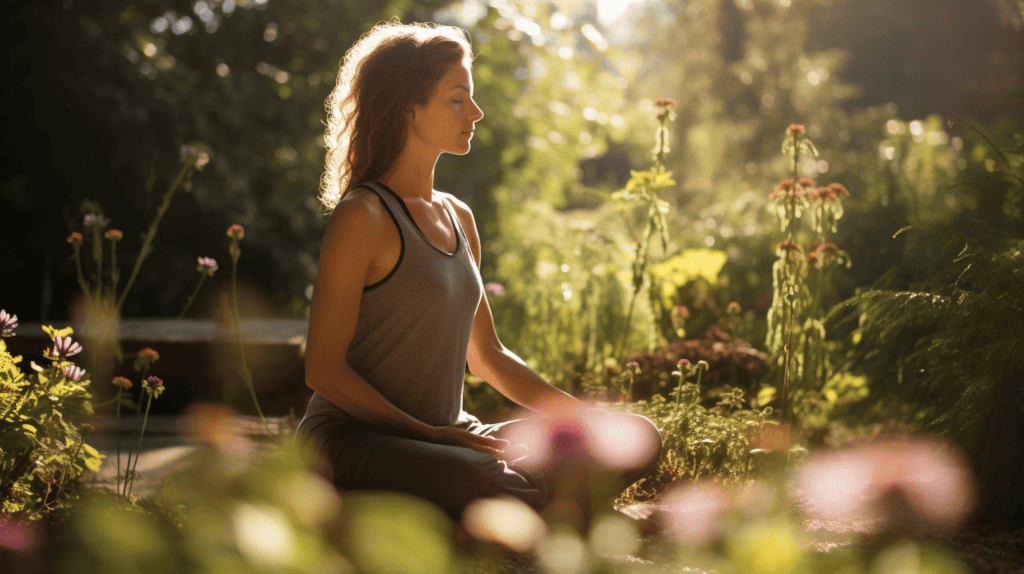Meditation is a powerful form of spiritual practice that can lead to profound shifts in awareness and perception. For beginners interested in exploring meditation for spiritual growth and inner peace, this comprehensive guide aims to equip you with everything you need to start a consistent meditation practice.
We will cover the meaning of spiritual meditation for beginners, the many benefits of meditation for beginners, how to prepare for your practice, useful meditation techniques and mindfulness exercises geared for novices, and actionable tips to help you cultivate inner peace and receive spiritual guidance. Equipped with the insights here, your meditation practice can bloom into an enriching inner journey toward spiritual awakening.
Key Takeaways
- Spiritual meditation trains focus and expands awareness beyond mental conditioning to attune to the luminous presence underlying all phenomena and connect with one’s boundless true nature.
- A dedicated meditation practice yields powerful benefits including peace, clarity, emotional intelligence, heightened vitality, compassion and access to intuitive inner guidance.
- Prepare properly and explore types like mindfulness, visualization and mantra before committing to a style of spiritual meditation—the consistency shapes progress.
- To realize spiritual awakening, integrate the qualities and insights from meditation into everyday living—intentionally radiate the consciousness modeled on the cushion into conduct, contribution and relating.
What is Spiritual Meditation?
Spiritual meditation is the mindful practice of focusing inward to connect with one’s higher or true nature. Beyond stress relief or relaxation, the core aim of spiritual meditation is to tap into the peace, wisdom, and liberation that rests within all of us.
Meditation enables us to slow down, observe the habitual patterns of thoughts and emotions, and realign with our deepest essence beneath all the mental chatter. This process of disidentifying from the constant flux of thoughts is what allows us to attune inwardly to the presence of our boundless being—to sense the energetic aliveness within and around us and awaken to a sacred place of innate wholeness.
The term “spiritual” hints that meditation is not just about paying attention or training concentration. Meditation here serves as a portal into the spiritual realm—into subtle yet profound states of awareness that connect us more intensely with self, others, and some greater life force permeating everything in existence.
MagnifyMind explains that spiritual meditation helps connect with your higher self and deepen your relationship with the Divine, quieting mind chatter to connect with your authentic inner voice.
Spiritual meditation thus opens and sensitizes us to the mystical unseen energies that animate the visible world. Over time and with practice, an inner architecture starts to form that orients our consciousness toward the light within. From this space, we gain a deeper understanding of life’s meaning that fundamentally transforms how we view ourselves, others, and the world.
Benefits of Spiritual Meditation
For beginners who start to meditate, it helps to clarify the incredible range of spiritual meditation benefits you stand to gain. Here is an overview:
Enhanced Mindfulness and Focus
- Improved concentration, willpower, self-control
- Increased ability to stay present in the moment
- Heightened monitoring of thoughts and emotions from moment to moment (meta-awareness)
Stress Relief and Relaxation
- Reduced anxiety, worry, impatience, anger, and reactivity
- Balanced nervous system activity promoting overall calm
Emotional Intelligence and Self-Mastery
- Expanded emotional granularity and vocabulary for inner experiences
- Deeper self-understanding enabling higher emotional intelligence
- Greater self-acceptance, self-confidence, and trust
Interconnectedness and Compassion
- A felt sense of connection to all of life
- Increased empathy, kindness, patience toward oneself and others
The benefits spill over into everyday living. With spiritual insights absorbed from meditation, you start relating to challenges, people, and situations from a more conscious standpoint. Over time, even subtle shifts lead to significant positive transformations in all aspects of life.
Tip: Establish clarity on your motivation and intended benefits before starting a meditation practice. Periodically reflect on your original purpose to realign your efforts toward your evolving spiritual goals.
Preparing for Your Spiritual Meditation Practice
To start out smoothly as a meditation novice, here are some beginner guidelines around best practices for your sit:
Set up a regular time and quiet space: Block off 5-15 minutes daily when you can withdraw to a clean, quiet spot at home devoid of distractions. Establishing spatial and temporal consistency conditions the mind-body system to enter a calm, relaxed state.
Adopt a stable, grounded posture: Sit cross-legged on a cushion/mat or upright on a chair with a straight spine. Relax your face, neck, shoulders while keeping the torso elongated. Proper posture enhances energetic flow and mental acuity.
Note the effects before and after practice: Pay close attention to physical sensations, moods, and thought patterns before sitting, immediately after, and even hours later in your day. Make notes to increase clarity on the changes occurring.
From The Yoga Nomads, setting up a calm and quiet environment is crucial for successful spiritual meditation, recommending a distraction-free space with a calming ambiance.
Now we’re ready to try out some accessible spiritual meditation techniques suitable for beginners.
Types and Techniques of Spiritual Meditation
Many forms of seated, spiritual meditation exist, some ancient and others modern variants. Below are three primary types with starter techniques to suit first-time practitioners:
1. Mindfulness Meditation
This contemporary technique builds the faculty of moment-to-moment awareness. The instruction here is simple:
- Find a meditative posture and relax your body
- Close your eyes if comfortable and bring focus to bodily sensations
- Tune into the natural breath, following each inhalation and exhalation with mindful presence
This exercise trains concentration while anchoring awareness in the physical. Sensations, thoughts, and emotions will invariably arise, at which point one gently redirects attention back to the breaths. Start with 5-10 minutes per day.
2. Guided Meditation Visualization
If you yearn for a more active, sensory-rich journey:
- Sit, close your eyes, and take a few deep breaths
- Imagine a beautiful natural landscape like a beach, forest, or field
- Engage all your senses as you visually traverse the scene: sights, textures, smells, sounds etc.
- Allow feelings and reflections to organically surface; gently return back whenever the mind wanders
Creative inner envisioning engages right-brain faculties, bringing lightness and intuitive openings. This is also a powerful way to manifest goals.
3. Mantra Meditation
For those drawn to spirituality ideas from world wisdom traditions:
- Sit comfortably with eyes closed
- Focus all attention on your breath flowing through the body
- Start silently chanting a mantra like “Om” or “Ham-sa” on each outbreath
- Sync the mantra with your exhalations
- Visualize each utterance radiating positivity outward into the world
Sound vibration is spiritually activating and shifts brainwave state. Mantras infuse presence and intention into practice.
Experiment with styles at first to discover what resonates. Then, commit to one technique for a month before assessing if to continue or try something new. What matters most is to make spiritual meditation a consistent, dedicated practice.
Cultivating Inner Peace through Spiritual Meditation

In stillness, our turbulent mental state settles and we access a profound backdrop of peace behind all the drama.
By continually returning attention to the present moment, we short-circuit destructive trains of thought from the past and future. Mindfulness grants us refuge from endlessly replaying old memories or preplaying imagined scenarios—the root source of stress.
Spiritual meditation allows us to cultivate equanimity through nonreactivity. We can learn to view even unpleasant thoughts and emotions with grace rather than getting possessed by them. This builds extraordinary resilience to life’s ups and downs.
With time, the warm easeful peace accessed during practice seeps into daily living. We relate to people and situations from a more composed, conscious space within. Meditation grants us sovereignty over previously unconscious, reactive patterns.
Ultimately, the experience of abiding peace and free-flowing compassion becomes the new normal—entirely through one’s own intentional practice to presence and positive states through spiritual meditation.
Accessing Higher Guidance from Within
All forms of spiritual meditation align to the same purpose: to transcend our narrow egoic identity and tap into higher states of wisdom ever-accessible within.
When we quiet the relentless inner voice of the intellect, we sensitize to the gentle luminous presence resting underneath—the voice of our higher self. Think of spiritual meditation as a bridge toward this ultimate enlightened nature.
This higher aspect of being remains untouched by worldly matters. From this space emerges profound insight about ourselves, others, life situations and our interconnectedness with all beings. Solutions seem to present themselves intuitively during or after practice.
With sincere aspiration, spiritual meditation unlocks our inner guru—the wellspring of unconditional love, creative dynamism and transcendental freedom that seeks to guide our thoughts and actions toward our highest good.
This inner compass innately points toward truth, beauty, wisdom and contribution to others. By learning to source from within, we receive all the teaching and healing we need for self-realization and world betterment.
Incorporating Spiritual Meditation into Everyday Living
For lasting transformation through spiritual practice, the insights must integrate into everyday decisions and behaviors—not remain compartmentalized to the cushion or quiet room.
Here are tips to make your spiritual meditation practice a lived reality:
- Set an intention at the start of each meditation focused on manifesting some positive quality like self-acceptance, creativity or service to others
- Take mindfulness breaks during the day to check in with the body and breath, recenter in the now
- Review insights gained during meditation and reflect on how to apply them in speech and conduct
- When stressed, pause to reconnect with sensations of inner spaciousness from prior meditations—this instantly infuses peace
- Practice seeing all beings as spiritual kin; interact with empathy and care in light of this vision
As the divide between formal practice and post-meditation daily living blurs, you implant the seeds for an enlightened way of living through your every thought, word, and deed. Your meditation starts to permeate every aspect of life as you begin to live your spiritual awakening.
Conclusion on Spiritual Meditation for Beginners
In stillness lies peace. In self-observation lies wisdom. In letting go lies freedom. Spiritual meditation opens the doorway—the rest is left to your sincerity and commitment to walk the path within.
By learning to bow in humble respect to the present moment, we surrender control over reality being different than it is. This single gesture aligns us with the harmonizing power of existence and initiates the profound interplay of awakening.
May this guide support your voyage toward the vast ocean of peace, love and liberation that awaits within. Bon voyage!
FAQ on Spiritual Meditation Benefits
Q: What is the significance of connecting with your higher self in spiritual meditation for beginners?
A: In spiritual meditation, the connection with your higher self is highly significant. It relates to personal growth and spiritual awareness. By connecting, you may receive intuitive guidance and insights that could deepen your spiritual journey. It’s about forming a stronger bond with your inner personality and spiritual path.
Q: How does one engage in spiritual meditation at the beginner level?
A: Engaging in spiritual meditation as a beginner involves a few steps. First, find a quiet place where you won’t be disturbed. Sit in a comfortable position, you may sit on a chair or on the floor. Close your eyes and focus on your breath. Take a few moments to relax yourself, then bring your attention inward and pave the way for a spiritual experience. Regular meditation can help you to meditate spiritually by improving your ability to focus and silence mind chatter.
Q: Are there different types of spiritual meditation techniques for beginners?
A: Yes, there are several types of spiritual meditation techniques that beginners can try. These include affirmation, visualization meditation and focusing on an object or concept. Each technique aims to help you focus your mind, gain spiritual awareness, and promote a sense of peace and clarity.
Q: How can I practice spiritual meditation to awaken my higher self?
A: To engage in spiritual meditation and awaken your higher self, you may start with visualization meditation or use a form of spiritual meditation that resonates with you. It’s about being present in the moment, focusing on your breath while allowing your intuition to guide you. It could also help to ask your higher self for guidance during your meditation sessions.
Q: How does spiritual meditation help my spiritual journey?
A: Spiritual meditation can help deepen your spiritual journey by enhancing your connection with the divine and your higher self. It allows you to explore your spiritual path in a profound way, helping you to gain insights that may contribute to your personal growth.
Q: What exactly is a spiritual awakening and how does meditating assist in achieving it?
A: A spiritual awakening is a process of deep inner transformation and self-realization. It is becoming aware of your true nature and connection to the universe. Meditation, especially spiritual meditation, assists in achieving it by helping you quiet your mind, focus inward and establish a strong connection with your higher self and the divine, thereby facilitating spiritual enlightenment.
Q: How is spiritual meditation different from other forms of meditation?
A: Spiritual meditation differs from other forms of meditation in its goal and focus. It’s more focused on the connection with your higher self, personal growth and spiritual awareness while other forms may focus on stress reduction, emotional health or physical relaxation. However, all types of meditation promote mindfulness and present moment awareness.
Q: Can I ask my higher self for guidance while practicing spiritual meditation?
A: Yes, asking your higher self for guidance during spiritual meditation is a common practice. Your higher self is believed to have wisdom, understanding, and a broader perspective. So, tuning into this guidance during meditation can help you gain clarity and make decisions aligned with your spiritual path.
Q: How long should a beginner meditate for spiritual purposes?
A: For a beginner, starting with small increments, such as 5 to 10 minutes a day, is recommended. As you get more comfortable with the practice and are able to maintain focus for longer periods, you can gradually increase the duration of your spiritual meditation sessions. Regular meditation helps deepen your spiritual connection and journey.
Q: What benefits can I expect from practicing spiritual meditation?
A: Practicing spiritual meditation helps to deepen your connection with your higher self, promote inner peace, enhance self-awareness, and fosters personal growth. It also brings about a heightened sense of present moment awareness. Over time, these benefits contribute to spiritual awakening and aid you in navigating your spiritual journey with more insight and clarity.





Leave a Reply